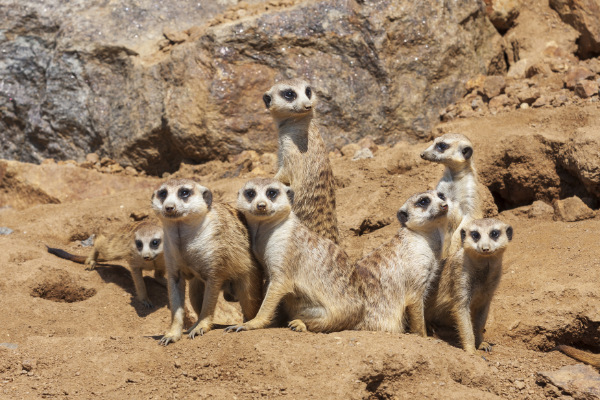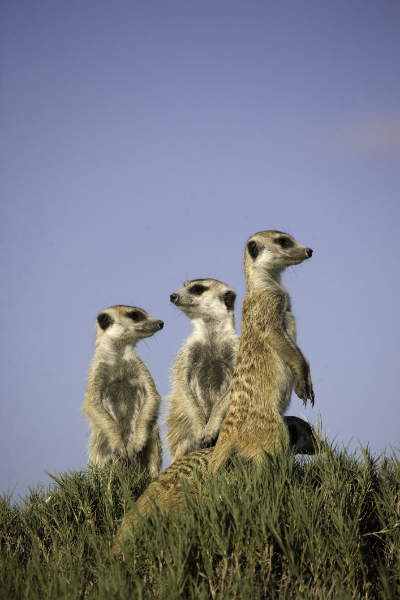Perhaps the most famous animal in the mongoose family, meerkats are well-known for their perfect posture and adorable appearance. For anyone else who was hooked on the series Meerkat Manor, you’ll know that meerkats are fascinating creatures with bundles of personality. And while you might be more familiar with the dressing gown-clad meerkat from that advertising campaign, read our list of the top ten meerkat facts to become an expert on the real deal.
1. Desert Lovers
2. Mob Mentality
3. Underground Homes
4. Small Stature
5. Guard Duty
6. Brilliant Babysitters
7. Water-Phobia
8. Vocalisation Variety
9. Enviable Vision
10. Omnivorous Diets
1.
Desert Lovers
Kicking off our list of facts about meerkats is one about habitats. Meerkats call the deserts and grasslands of southern African countries home, so head to the vast Kalahari Desert in Botswana, Namibia and South Africa, or to the coastal Namib Desert, to be in with the chance of spotting a wild meerkat. In order to survive in these harsh desert conditions, the marvellous mammals can thermoregulate (meaning they maintain a specific body temperature).
2.
Mob Mentality
Now for one of our favourite meerkat facts: a group of meerkats is called a ‘mob’. Not the gangster kind, though; meerkat mobs are nothing of the sort. Instead, mobs rely on each other, taking turns to gather food, look out for predators, and take care of the young. Mobs are, on average, made up of ten to 15 individuals, often from different families. And like any society, there’s a hierarchy. Each mob has alphas – leaders who breed and help the group flourish – and betas, who primarily raise the pups. Meerkat mobs are also very territorial. One study found that up to 20% of meerkat deaths resulted from fights between rival mobs…
3.
Underground Homes
To escape the hot African sun, meerkat mobs live underground in burrows below the open plains. Using their sharp claws to dig underground, these cosy burrows can have lots of entrances, tunnels and rooms, and are typically dug five ft below ground. Meerkat burrows are on average 16 ft long, and contain separate chambers for sleeping and going to the bathroom. Who knew meerkats were so civilised?
4.
Small Stature
Next up on our list of meerkat facts is a note on their size. Here’s a clue: they’re small. With a body length averaging 29cm (excluding their tails), meerkats are slender creatures with zero body fat. This means they have no energy reserves to draw upon, however, so they spend as many as five to eight hours a day foraging for food (more on that later). On average, meerkats weigh less than one kilogram – that’s lighter than a litre of water, a pineapple or a small bag of rice.

5.
Guard Duty
Picture a meerkat. Is it perched up on its hind legs looking alert? We thought so. This iconic posture is adopted by the ‘sentry’ of the mob, whose job is to find a high point and keep watch for danger. While the rest of the group is foraging for food, sentries scan the landscape for predators such as jackals, eagles and snakes. If they spot anything amiss, they’ll let out a warning squeal which sends the mob scrambling for safety. Meerkats are well-prepared for these scenarios, digging ‘bolt holes’ (safe hiding places) throughout their foraging area for emergencies.
6.
Brilliant Babysitters
Any list of meerkat facts must include a reference to their excellent babysitting skills. In each mob, several babysitters are assigned to look after and protect newborn pups – also known as ‘meerkittens’. Adorable. Meerkats are diurnal animals (active during the day), so when the sun comes up, the foragers and sentries head out and the babysitting shift begins. And while a babysitter might go all day without food, duties rotate around the mob, so all members can get in on the action above ground.
7.
Water-Phobia
Although these endearing desert-dwellers love the heat, did you know that they don’t drink water? While other animals flock to waterholes to quench their thirst, you’ll never see meerkats in tow. In fact, meerkats get all they need from their food. By absorbing the water inside the plants and animals that they eat, meerkats keep their hydration levels steady.

8.
Vocalisation Variety
Meerkats are very intelligent animals (if you haven’t already guessed). And as social animals, they are also very vocal. While their yelps, growls and spits might seem indistinguishable to us, one study found that meerkats used 12 different vocalisations when communicating in a variety of situations. Depending on the activity, be it babysitting, digging, foraging or sunbathing, meerkats have a distinct way of communicating.
9.
Enviable Vision
Ever wondered why meerkats have darker patches of fur around their eyes? Aside from adding to their cuteness, experts think this might be an evolutionary adaptation related to their harsh desert home. Helping to reduce the sun’s glare, this fur makes it easier for our little friends to see further into the expanse of bright desert, and, – crucially – means they can sound the alarm more quickly if they spot danger.
10.
Omnivorous Diets
Despite their small stature and lovable appearance, you might be surprised to learn that meerkats are wonderful hunters. Meerkats are omnivores, with diets including everything from beetles, plants and fruit to small birds, reptiles and scorpions. When the latter arachnid is on the menu, meerkats have learnt to bite off the scorpion’s stinger before tucking in. As part of the mongoose family, they’re also immune to certain types of venom. How’s that for a fact about meerkats?
Written by Hannah Whitehall













